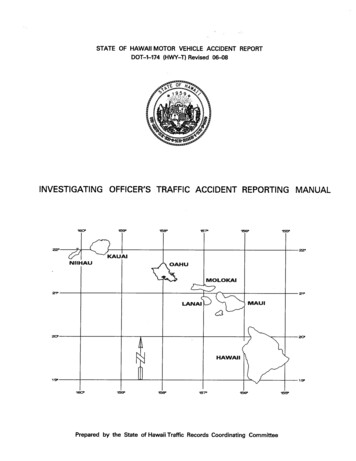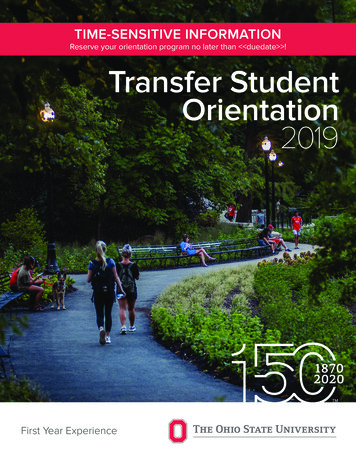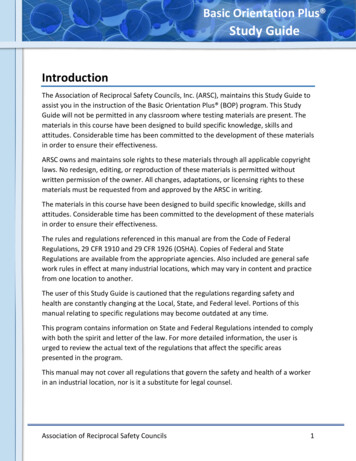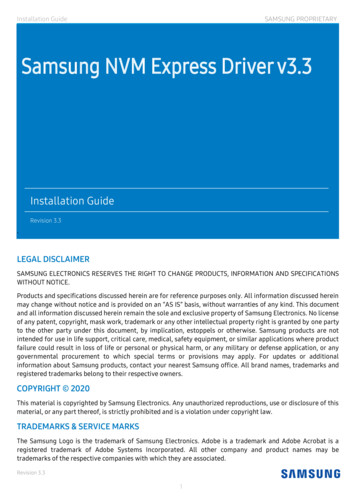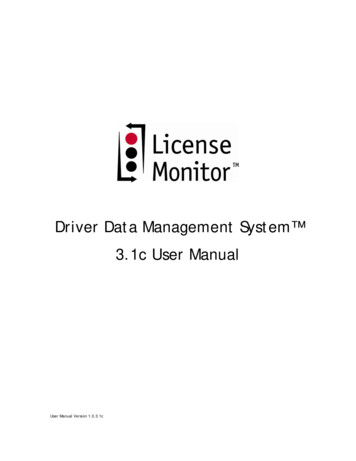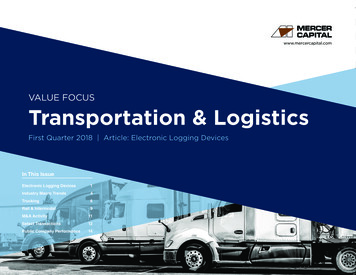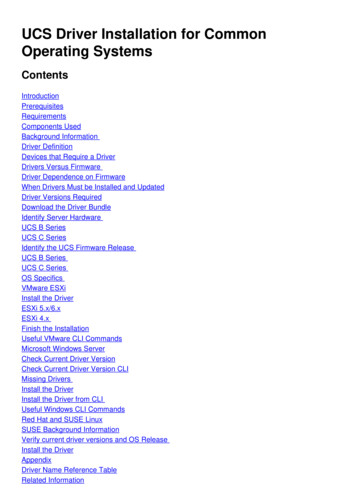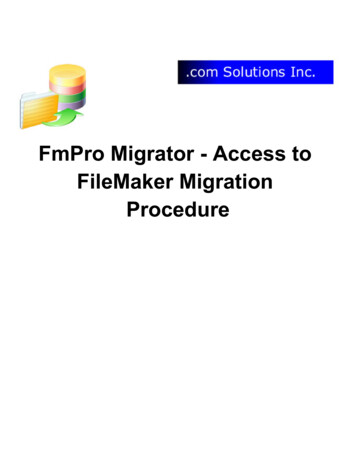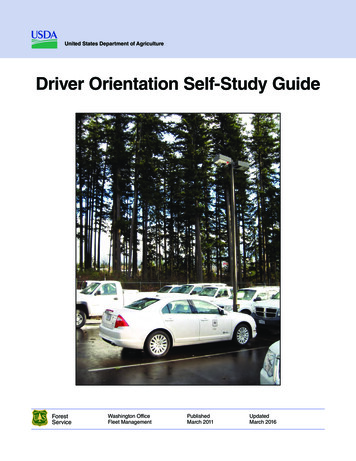
Transcription
United States Department of AgricultureDriver Orientation Self-Study GuideForestServiceWashington OfficeFleet ManagementPublishedMarch 2011UpdatedMarch 2016
Driver Orientation Self-Study Guide
Driver OrientationSelf-Study GuideUSDA Forest ServiceWashington OfficeFleet ManagementMarch 2011Updated March 2016I n accordance with Federal civil rights law and U.S. Department of Agriculture (USDA) civil rightsregulations and policies, the USDA, its Agencies, offices, and employees, and institutions participatingin or administering USDA programs are prohibited from discriminating based on race, color, nationalorigin, religion, sex, gender identity (including gender expression), sexual orientation, disability,age, marital status, family/parental status, income derived from a public assistance program, politicalbeliefs, or reprisal or retaliation for prior civil rights activity, in any program or activity conducted orfunded by USDA (not all bases apply to all programs). Remedies and complaint filing deadlines varyby program or incident.Persons with disabilities who require alternative means of communication for program information(e.g., Braille, large print, audiotape, American Sign Language, etc.) should contact the responsibleAgency or USDA’s TARGET Center at (202) 720-2600 (voice and TTY) or contact USDA through theFederal Relay Service at (800) 877-8339. Additionally, program information may be made available inlanguages other than English.To file a program discrimination complaint, complete the USDA Program Discrimination ComplaintForm, AD-3027, found online at http://www.ascr.usda.gov/complaint filing cust.html and at anyUSDA office or write a letter addressed to USDA and provide in the letter all of the informationrequested in the form. To request a copy of the complaint form, call (866) 632-9992. Submit yourcompleted form or letter to USDA by: (1) mail: U.S. Department of Agriculture, Office of the AssistantSecretary for Civil Rights, 1400 Independence Avenue, SW, Washington, D.C. 20250-9410; (2) fax:(202) 690-7442; or (3) email: program.intake@usda.gov.USDA is an equal opportunity provider, employer, and lender.The Forest Service, an agency of the U.S. Department of Agriculture (USDA), has developed thisinformation for the guidance of its employees, its contractors, and its cooperating Federal and Stateagencies. The Forest Service assumes no responsibility for the interpretation or use of this informationby anyone except its own employees. The use of trade, firm, or corporation names is for the information and convenience of the reader. Such use does not constitute an official endorsement or approval ofany product or service to the exclusion of others that may be suitable. Executive Summary.
Driver Orientation Self-Study GuideContentsChapter 1—Introduction . . . . . . . . . . . . . . . . . . . . . . . . . . . . . . . . . . . . . . . . . . . . . . . . . . . . . . . . . . . . . . . . . . . . . 1Steps for Obtaining Your OF-346 . . . . . . . . . . . . . . . . . . . . . . . . . . . . . . . . . . . . . . . . . . . . . . . . . . . . . . . . . . . 2Chapter 2—Working Capital Fund Overview . . . . . . . . . . . . . . . . . . . . . . . . . . . . . . . . . . . . . . . . . . . . . . . . . . . . . 3Fixed Ownership Rates . . . . . . . . . . . . . . . . . . . . . . . . . . . . . . . . . . . . . . . . . . . . . . . . . . . . . . . . . . . . . . . . . . . 3USE . . . . . . . . . . . . . . . . . . . . . . . . . . . . . . . . . . . . . . . . . . . . . . . . . . . . . . . . . . . . . . . . . . . . . . . . . . . . . . . . . . . 4Chapter 3—USE Reporting and Log Books . . . . . . . . . . . . . . . . . . . . . . . . . . . . . . . . . . . . . . . . . . . . . . . . . . . . . 5Chapter 4—Fleet Credit Card . . . . . . . . . . . . . . . . . . . . . . . . . . . . . . . . . . . . . . . . . . . . . . . . . . . . . . . . . . . . . . . . . 6Chapter 5—Accident Reporting . . . . . . . . . . . . . . . . . . . . . . . . . . . . . . . . . . . . . . . . . . . . . . . . . . . . . . . . . . . . . . . 8Vehicle Safety Items . . . . . . . . . . . . . . . . . . . . . . . . . . . . . . . . . . . . . . . . . . . . . . . . . . . . . . . . . . . . . . . . . . . . 11Chapter 6—Using Government Vehicles . . . . . . . . . . . . . . . . . . . . . . . . . . . . . . . . . . . . . . . . . . . . . . . . . . . . . . . 12Chapter 7 —Daily and Monthly Preventative Maintenance Checks . . . . . . . . . . . . . . . . . . . . . . . . . . . . . . . . . 14Daily Before-Operation Check (also known as the “Circle of Safety”) . . . . . . . . . . . . . . . . . . . . . . . . . . . . 14Monthly Preventive Maintenance Inspections . . . . . . . . . . . . . . . . . . . . . . . . . . . . . . . . . . . . . . . . . . . . . . . 14Chapter 8—Scheduled Maintenance and Repairs . . . . . . . . . . . . . . . . . . . . . . . . . . . . . . . . . . . . . . . . . . . . . . . 16Chapter 9—Emergency Repairs . . . . . . . . . . . . . . . . . . . . . . . . . . . . . . . . . . . . . . . . . . . . . . . . . . . . . . . . . . . . . . 17Breakdowns on Your Unit . . . . . . . . . . . . . . . . . . . . . . . . . . . . . . . . . . . . . . . . . . . . . . . . . . . . . . . . . . . . . . . . 17Breakdowns off Your Unit . . . . . . . . . . . . . . . . . . . . . . . . . . . . . . . . . . . . . . . . . . . . . . . . . . . . . . . . . . . . . . . . 17Chapter 10—Additional Required Reading . . . . . . . . . . . . . . . . . . . . . . . . . . . . . . . . . . . . . . . . . . . . . . . . . . . . . 18ii
Driver Orientation Self-Study GuideChapter 1—IntroductionThe Forest Service wants to ensure that you are fullyqualified to operate Forest Service owned, leased, or rentedvehicles and equipment safely and effectively (FSH 7109.19,sec. 60.3).This orientation course includes reading material thatcovers: Working capital fund (WCF) Mileage records (USE) Use of the Government fleet fuel credit card Accident reporting procedures Official use of Government vehicles Preventive maintenance policies Scheduled maintenance and repairs Emergency repairsSupplemental videos or other training materials may beprovided by your local unit and include: Driving on mountain roads and under unique conditions All-wheel drive (4x4) vehicle operation Use of antilock brake systems (ABS) and air bagsThis training pertains to the care and operation of theequipment during normal and emergency work assignmentsin Forest Service employment. Before you will be issued anOF-346 (U.S. Government Motor Vehicle Operator’s Identification Card) or equivalent driver/operator authorization,you must possess a valid State driver’s license for the typesof Forest Service vehicles you will be driving, including anynecessary endorsements (FSM 7134.1).When you have finished reading this guide, you will befamiliar with vehicle requirements and may be tested basedon the information provided.Additional training and testing will be required forvehicles weighing more than 10,000 pounds GVWR (grossvehicle weight rating) and specialized equipment. Authorization to operate additional equipment will be added to yourOF-346, after certification of successful completion of training and testing.OF-346, U.S. Government Motor Vehicle Operator’s Identification CardOF 34611/85 USOPMFPM Chapter 930U.S. Government Motor Vehicle Card No.Operator’s Identification Card 0515- 000Name of Operator (not transferable) Sex Signature of Operator (not valid until signed)RestrictionsQualified To OperateType Vehicle and/or EquipmentBasic and All-Wheel-Drive VehiclesDate of BirthHeightState License No.CapacityQualifying Official 10,000 GVWName and Location of Issuing UnitWeight Hair Color Eye ColorSignature and Title of Issuing OfficialDate IssuedDate ExpiresForest Vehicle/Operator ExaminerThe holder of this card is qualified to operate U.S. Government vehicles and/orequipment specified, subject to the restrictions set forth on the other half of this card.Card must be carried at all times when operating Government vehicles.Void Unless Accompanied By A Valid State LicenseNSN 7540-00-634-39950346-11
Driver Orientation Self-Study GuideSteps for Obtaining Your OF-346The driver completes the following: Application for Authorization To Operate Government Vehicles and Equipment, sec. 1 (FS-7100-184) Current driver record information (National DriverRegister or State record check) Forest Service driver orientation (this guide) Basic test (may be waived for vehicles under 10,000GVWR, per local requirements) Specialized equipment training and test(s), if requiredThe driver’s supervisor completes the following: Application for Authorization To Operate Government Vehicles and Equipment, sec. 2The driver examiner completes the following: Application for Authorization To Operate Government Vehicles and Equipment, sec. 3When you, your supervisor, and the driver-operatorexaminer have successfully completed all the requirements,you will be issued an OF-346 or equivalent. Your OF-346must be accompanied by your valid State driver’s license.Both must be in your possession at all times while driving or operating Government-owned or -leased vehiclesand equipment (FSM 7134.2; FSH 7109.19, secs. 61.1 and61.2)You must complete the minimum required training andtesting for specialized equipment. Previous training, testing,and experience—when verified—may be accepted for qualification in place of Forest Service on-the-job training. Experience must have been within the previous 4 years. Your supervisor will have to verify your skills. Written and performancetesting will still be required (FSH 7109.19, sec. 64.1).2A commercial driver’s license is required for: Vehicles 26,001 pounds GVWR or heavier Any combination of vehicles with a GCWR (grosscombined weight rating) of 26,001 pounds or more,provided the GTWR (gross trailer weight rating) ofthe towed unit is 10,000 pounds or more (some Stateshave more restrictive license regulations for towing) Tank trucks carrying 1,000 gallons or more Passenger vehicles carrying more than 10 passengersin California or 16 or more passengers in all otherStates Vehicles transporting hazardous materials that requireplacards or markingsYou must be able to pass a physical and the commercialdriver’s license test(s) to qualify to operate these types ofForest Service vehicles. Employees whose position requiresa commercial driver’s license will be enrolled in the agencydrug and alcohol testing program (FSH 7109.19, sec. 63.4)and shall maintain a current medical certificate.FSH 7109.19–Fleet EquipmentManagement Handbook65.01–Commercial Driver’s License Forest Service drivers shall not seek oraccept an exemption from the requirementsto have a commercial driver’s license tooperate a commercial motor vehicle even ifthe State provides such a waiver for emergency vehicles.
Driver Orientation Self-Study GuideChapter 2—Working Capital Fund OverviewForest Service (agency-owned) fleet vehicles and equipment are purchased and maintained using the Working Capital Fund (WCF). The WCF is a self-sustaining accountingsystem, similar to some used in private enterprise. A numberof activities within the Forest Service use this accounting system to manage their funds.For fleet equipment, the primary function of WCF is tosupport the Forest Service by providing efficient and safefleet equipment and to ensure the economical acquisition,operation, maintenance, and disposal of that equipment.WCF includes two distinct accounts: fixed ownershiprates (FOR) and use rates (USE).Fixed Ownership RatesFOR is a monthly rate covering the fixed costs of equipment ownership. Replacing the vehicle at the end of a setlife is the major fixed cost. Management and overhead areadditional fixed costs. “Profits” (when WCF receives morerevenue than needed to cover costs) and “losses” can lead toincreases or decreases in FOR. The three basic parts of FORare:Depreciation— Depreciation accounts for about 75 percent of the cost of a new vehicle and allows the Forest Service to recover the dollars paid for the vehicle when it waspurchased. About 25 percent is recovered when the vehicle issold.Increased Replacement Cost (IRC)— This factor isbased on the difference between the vehicle’s original purchase price and the cost of the vehicle that will replace it. Thedifference is mostly due to inflation, but may also includecosts of advances in technology.Fixed Ownership %Depreciation73%Program Management— Program management (PM)and administrative costs are about 20 percent of the FOR.This part of the FOR covers the administrative costs of running the fleet program at all levels in the Forest Service.If vehicles are maintained and kept in good condition,the Forest Service can recover more of its investment whenvehicles are sold, which will help keep FOR rates low.FOR is collected monthly and charged to the benefitingfunction that has possession of the vehicle on the first day ofthe month. FOR budgets are set up in the beginning of eachfiscal year with the project manager determining project jobcodes that will pay for the vehicle during each month.3
Driver Orientation Self-Study GuideUSEUSE is the cost you pay for operating and maintaininga Forest Service vehicle. It includes fuel, tires, lube and oilservice, washing, mechanical inspections, and repairs. Someregions, stations, or units include auto shop operation andmaintenance costs in USE.USE rates (vehicle operation and maintenance cost) arecalculated using a 3-year average of the repair costs and thepast year’s operations costs for all vehicles of the same type(for example, ½ ton 4x2 regular cab pickup) on your NationalForest. USE rates are charged for each mile or hour the vehicle or equipment is operated.USE rates do not cover the costs of unusual maintenanceand repairs (as determined by the fleet manager) or repairsresulting from misuse, abuse, or accidents. These costs arecharged directly to your project funds. In the case of negligence, these costs could be charged directly to the driver.You, the driver, are the key to reducing costs.4Tips To Reduce VehicleOperating Costs Complete all preventivemaintenance promptly. Maintain your vehicles onschedule. Drive to conserve fuel. Do not use premium gradefuels. Maintain proper tire pressures, control speed, andavoid skidding to extendtire life. Do not overload yourvehicle.
Driver Orientation Self-Study GuideChapter 3—USE Reporting and Log BooksExample of Use Report/Log BookTo report WCF fleet equipment USE: Record your units of USE (miles, hours, days) eachday. Report your units of USE each month. Distribute all units of USE to valid job codes.FLEET EQUIPMENT DAILY USE RECORDWCF Equipment Number: or License Plate:FOREST:DAYBEGINNINGODOMETERBEGINNING ODOMETER:ENDINGODOMETERTOTALMILESMONTH:JOB CODEFuel/Mtnce. Yesor NoFISCAL YEAR:DRIVER'S NAMEPrintLegibly1On the due date determined by your region, station, orarea, the designated operator must submit a record of thetotal units of USE during the prior month along with validjob code(s) to cover the USE charges. Additional informationmay be required by your unit (FSH 6509.11f, sec. 34.1).Different regions, stations, or areas may use differentforms and methods for collecting this information. See yoursupervisor or fleet manager for specific instructions on completing the form used on your unit.Your reported USE record needs to be complete andaccurate when you turn it in. Inaccurate USE reportingaffects your project’s bottom line.Log books are required by the U.S. Department of Agriculture policy (Department Regulation DR 5400-006) todocument vehicle/equipment use. The USE record and logbook may be combined in one document. Information in thelog book is also used to support “days of use” in the annualutilization 728293031INSTRUCTIONS: Record each day that this vehicle is used. Tally all days used for this month:Initial next day's use if no changes. Record all credit card use and retain all receipts in this envelope.****SUBMIT THIS ENVELOPE TO YOUR UNIT FLEET MANAGER MONTHLY****R1-FS-7130-2 (3-10)5
Driver Orientation Self-Study GuideChapter 4—Fleet Credit CardEach vehicle is assigned a fleet credit card. The fleetcredit card must be used to pay for all fuel, services, andrepairs of motor vehicles.In addition, your fleet credit card should be used to payfor tow services, car washes, and expendable items, such aswiper blades, motor oil, light bulbs, and similar items.Contact your fleet or maintenance manager for authorization before taking a vehicle to a commercial vendor formaintenance and repair work. Repairs or necessary vehiclepurchases up to 1,000 can be made by the operator usingthe fleet card after the operator has contacted the unit fleetmanager. Purchases/repairs between 1,000 and 2,500 mustbe authorized by the forest or station fleet manager (someunits may have established a lower card limit, such as 500).Purchases larger than 2,500 require advance approval froma warranted procurement person and the region/station/areafleet manager.For additional fleet credit card training or help withproblems associated with your card, contact your fleet manager.A 2007 Office of Inspector General (OIG) audit foundthat some Forest Service employees were not aware of thebasic requirements for using a fleet credit card. All employees should know the five basic requirements: The fleet credit card is for official Government business only. Under no circumstances is the card to beused for personal purchases or as identification forpersonal purchases (USDA Departmental RegulationNo. 5400-006). Only one fleet credit card can be issued to eachmotor vehicle, aircraft, boat, and piece of equipmentthat requires fuel. Anyone using a fleet credit cardassigned to a vehicle or piece of equipment shall usethe card only for the vehicle or piece of equipment towhich the card is assigned (OIG Audit 08601-03-TE,March 30, 2007; USDA Departmental Regulation No.5400-006). Anyone using a fleet credit card assigned to a vehiclewith an odometer must, whenever prompted by thecard machine, enter a valid odometer reading and PIN(personal identification number) when purchasing6fuel (OIG Audit 08601-03-TE, March 30, 2007;USDA Departmental Regulation No. 5400-006). Anyone using a fleet credit card must collect andmaintain a receipt for that transaction. Once a monththe receipts will be given to the Local Fleet ProgramCoordinator (OIG Audit 08601-03-TE, March 30,2007). Use the grade (octane rating) of fuel recommended bythe motor vehicle manufacturer when fueling motorvehicles owned or leased by the Government. Do notuse premium grade gasoline in any motor vehiclesunless the vehicle owner/operator manual specifiespremium grade gasoline (USDA Agriculture PropertyManagement Regulations (AGPMR) chapter 110-34;Federal Management Regulation (FMR), part 10234).Using the Fleet Credit Card Obtain a personal identification numberfrom the fleet manager before using thefleet card. Complete the mandatory fleet trainingbefore using a fleet card. All transactions are monitored and subjectto audit. Purchase of premium fuel is prohibited. All receipts for fleet credit card purchasesmust be retained and turned in with yourmonthly USE record. All receipts must be retained for auditingpurposes. Unauthorized purchases are prohibited. The fleet credit card must be secured atall times. Do not leave it in an unattendedvehicle where it might be stolen. Ensure (in advance) that the vendoraccepts the fleet credit card. Know the credit card’s limits.
Driver Orientation Self-Study GuideNew Credit Card for WCF (Working Capital Fund) VehiclesCredit cardDriver guideA copy of the“Driver Guide”should be keptin the vehicle’slog book.7
Driver Orientation Self-Study GuideChapter 5—Accident ReportingIt is the responsibility of the driver to report any and allaccident damage to their supervisor, no matter how slight(FSH 7109.19, sec. 42.3) and to complete the required paperwork immediately (FSH 6709.12, sec. 32.1).If you are involved in an accident, your authorizationto operate Forest Service vehicles or equipment may be suspended pending the outcome of the final accident investigation.The Government may defend any claim or suit againstthe operator of a Government-owned or -leased motor vehicleresulting from an accident, if the employee was acting withinthe scope of employment. If the employee was not actingwithin the scope of employment, the Government will notpay the claim and will not defend the suit. The Office of theGeneral Counsel decides whether the employee acted withinthe scope of employment.Each vehicle log book or glove box should contain anAD-651 Motor Vehicle Accident Report Kit or similar packet.This kit should include: Region, station, or unit instructions for reporting andinvestigating motor vehicle accidents SF-91 Motor Vehicle Accident Report SF-94 Statement of Witness CA-1 Federal Employee’s Notice of Traumatic Injuryand Claim for Continuation of Pay/Compensation AD-112 Report of Unserviceable, Lost, Stolen, Damaged, or Destroyed Property CA-16 Authorization for Examination and/or Treatment (optional) Pencil and note paperAD-651, Accident EnvelopeDefinition of an AccidentAn accident is an impact with any object that causes damage, however slight,to Forest Service‑owned or -leased equipment (FSH 7109.19, sec. 42.3).8
Driver Orientation Self-Study GuideSF91, Motor Vehicle Accident ReportMOTOR VEHICLEACCIDENT REPORTPlease read thePrivacy Act Statement on Page 3INSTRUCTIONS: Sections I through IX are filled out by the vehicle operator. Section X,items 72 thru 82c are filled on by the operator's supervisor. Section XI thru XIII are filled outby an accident investigator for bodily injury, fatality,and/or damage exceeding 500.SECTION I - FEDERAL VEHICLE DATA1. DRIVER'S NAME (Last, first, middle)2. DRIVER'S LICENSE NO./STATE/LIMITATIONS DATE OF ACCIDENT4a. DEPARTMENT/FEDERAL AGENCY PERMANENT OFFICE ADDRESS5. TAG OR IDENTIFICATION NUMBER4b. WORK TELEPHONE NUMBER6. EST. REPAIR COST 7. YEAR OF VEHICLE8. MAKE9. MODEL10. SEAT BELTS USEDYES NO11. DESCRIBE VEHICLE DAMAGESECTION II - OTHER VEHICLE DATA (Use Section VIII if additional space is needed)12. DRIVER'S NAME (Last, first, middle)13. SOCIAL SECURITY NO./TAX IDENTIFICATION NO.14. DRIVER'S LICENSE NO./STATE/LIMITATIONS15. a DRIVER'S WORK ADDRESS15b. WORK TELEPHONE NUMBER16a. DRIVER'SHOME ADDRESS16b. HOME TELEPHONE NUMBER17. DESCRIPTION OF VEHICLE DAMAGE18. ESTIMATED REPAIR COST19. YEAR OF VEHICLE20. MAKE OF VEHICLE21. MODEL OF VEHICLE23a. DRIVE'S INSURANCE COMPANY NAME AND ADDRESS 22. TAG NUMBER AND STATE23b. POLICY NUMBER23c. TELEPHONE NUMBER24. VEHICLE ISCO-OWNED25a. OWNER'S NAME(S) (Last, first, middle)25b. TELEPHONE NUMBERRENTALLEASEDPRIVATELY OWNED26. OWNER'S ADDRESS(ES)SECTION III - KILLED OR INJURED (Use Section VIII if additional space is needed)27. NAME (last, first, middle)28. SEX29. DATE OF BIRTH30. ADDRESSA31. MARK "X" IN TWO APPROPRIATE 5. TRANSPORTED BY32. IN WHICH VEHICLE 33. LOCATION IN VEHICLE34. FIRST AID GIVEN BYFEDOTHER (2)36. TRANSPORTED TO37. NAME (last, first, middle)38. SEX39. DATE OF BIRTH40. ADDRESSB41. MARK "X" IN TWO APPROPRIATE 5. TRANSPORTED BY42. IN WHICH VEHICLE 43. LOCATION IN VEHICLEOTHER (2)46. TRANSPORTED TOa. NAME OF STREET OR HIGHWAY47. Pedestrian44. FIRST AID GIVEN BYFEDb. DIRECTION OF PEDESTRIAN (SW corner to NW corner, etc.)FROMTOc. DESCRIBE WHAT PEDESTRIAN WAS DOING AT TIME OF ACCIDENT (crossing intersection with signal, against signal, diagonally; in roadway playing,walking, hitchhiking, etc.)NSN 7540-00-634-4041Previous edition not usableSTANDARD FORM 91(2/2004)Prescribed by GSA-FMR 102-34.2959
Driver Orientation Self-Study GuideAD-112, Report of Unserviceable, Lost, Stolen, Damaged, or Destroyed PropertyU.S. DEPARTMENT OF AGRICULTUREREPORT OF UNSERVICEABLE, LOST, STOLENDAMAGED OR DESTROYED PROPERTYPROPERTY REPORT NO.DATESECTION I - ACCOUNTABLE PROPERTY OFFICER'S REPORT1. STATUS OF PROPERTY (Check only one-report each one type separately)UnserviceableLost or StolenObsoleteCannibalized for partsDamagedDestroyed2. REPORTING ACTIVITY (Show agency, unit and address)Others3. PROPERTY ITEMS (See attachment for additional entries)ITEM DESCRIPTION AND OTHER DETAILS, INCLUDINGSERIAL NUMBERS AND ACQUISITION DATE(Give present condition and estimated cost of repair)BQUANTITY(Or property no.)AYou mustprovidethisinformationDriver’s name:EXPLANATION/DISPOSAL INSTRUCTIONS(If lost, stolen, or destroyed, give detail.Was this reported to proper authorities?)DACQUISITION COSTCVehicle acquisitioncosts:Description of damage and how it occurred:Vehicle ID number:Vehicle description:Commercial vehicle APO disposal instructions:repair estimate:Job code to cover repairs:4. NAME IN PRINT AND SIGNATUREOF CUSTODIANDATE5. NAME IN PRINT AND SIGNATUREOF ACCOUNTABLE PROPERTY OFFICERDATESECTION II - PROPERTY MANAGEMENT OFFICER'S REVIEW AND RECOMMENDATIONDETERMINATION FOR LOST, STOLEN, DAMAGED, OR DESTROYED PROPERTY1. After due consideration of all known facts and circumstances in this case, it is determined that:a. The loss, theft, damage or destruction did not result from employee negligence and avny involved employees are hereby relieved of liability.b. There appears to be gross negligence involved; therefore, the case returned to agency officials for appropriate action under the Debt Collection Act.c. There appears to be negligence involved; therefore, the case is returned to age ncy personnel officials for consideration of disciplinary action.2. NAME IN PRINT AND SIGNATURE OF PROPERTY MANAGEMENT OFFICER3. DATESECTION III - AUTHORIZATION FOR CANNIBALIZATION, ABANDONMENT, OR DESTRUCTION OFUNSERVICEABLE PROPERTY1. Unserviceable property listed above is hereby authorized for cannibalization, abandonment, or destruction in accordance with FPMR 101-45.9 based on any of the followingdeterminations as further explained in section I-3(D):a. Property has no commercial value.b. Health, safety, or security considerations require immediateabandonment or destruction.c. Costs of care and handling exceed expected small lot sales proceeds.e. Property is uneconomical to repair/not needed by anotheruser and may be cannibalized for parts. (Cannibalization isa form of use and property management regulations shall apply.Remainder of property must be disposed of throughusual procedures.)d. Regulation or directive requires abandonment or destruction.2. SIGNATURE OF PROPERTY MANAGEMENT OFFICER3. DATESECTION IV - CERTIFICATION FOR COMPLETION OF CANNIBALIZATION, ABANDONMENT, OR DESTRUCTION: I certify that cannibalization,abandonment, or destruction action for the items authorized under Section III was completed on this date in accordance with I-3(D).1. SIGNATURE OF ACCOUNTABLE PROPERTY OFFICER2. DATE3. SIGNATURE OF WITNESS4. DATESECTION V - CERTIFICATIONS OF PROPERTY AND FISCAL OFFICERS1. SIGNATURE OF PROPERTY MANAGEMENT OFFICER (The necessary entries have been made to adjust property records.)2. DATE3. SIGNATURE OF FISCAL OFFICER [The necessary action has been taken to adjust the accounting records and, wher e required by adetermination made under Section II above, to effect collection from involved e mployee(s).]4. DATEAD FORM 112 (Rev. 3/94)10
Driver Orientation Self-Study GuideVehicle Safety ItemsIn addition, each new vehicle will contain most or all ofthe following safety items: First aid kit Two body fluid barrier kits Fire extinguisher Highway warning devices (road triangles) Safety vest(s) Tire chains (if approved by vehicle manufacturer) Wheel chock block Flashlight Window scraperCheck monthly to ensure that dated supplies arereplaced. Projects are responsible for replacing any dated ormissing items.Common Safety Items11
Driver Orientation Self-Study GuideChapter 6—Using Government VehiclesSafety is number one when driving or operating anynecessary to accomplish mandatory goals. In these cases, thenonstandard use must be recognized and approved by boththe fleet manager and project staff officer before the use. Anycosts for repairs from nonstandard use will usually be paidfor by the benefiting function (FSH 7109.19, sec. 42.2).vehicles or Government equipment. Drivers and operators ofall Forest Service equipment shall strictly observe all traffic laws, ordinances, and regulations in both letter and spirit(EM–7130–2, p. 1) of the State or local community in whichthe vehicle is operated. They shall observe the accepted stanAbuse is damage caused by disregard for establisheddards of safe and defensive driving and shall exercise all pos- standards of use and maintenance. The cost of repairs forsible care to avoid accidents and shall not misuse or ab
Forest Service (agency-owned) fleet vehicles and equip-ment are purchased and maintained using the Working Capi-tal Fund (WCF). The WCF is a self-sustaining accounting system, similar to some used in private enterprise. A number of activities within the Forest S
